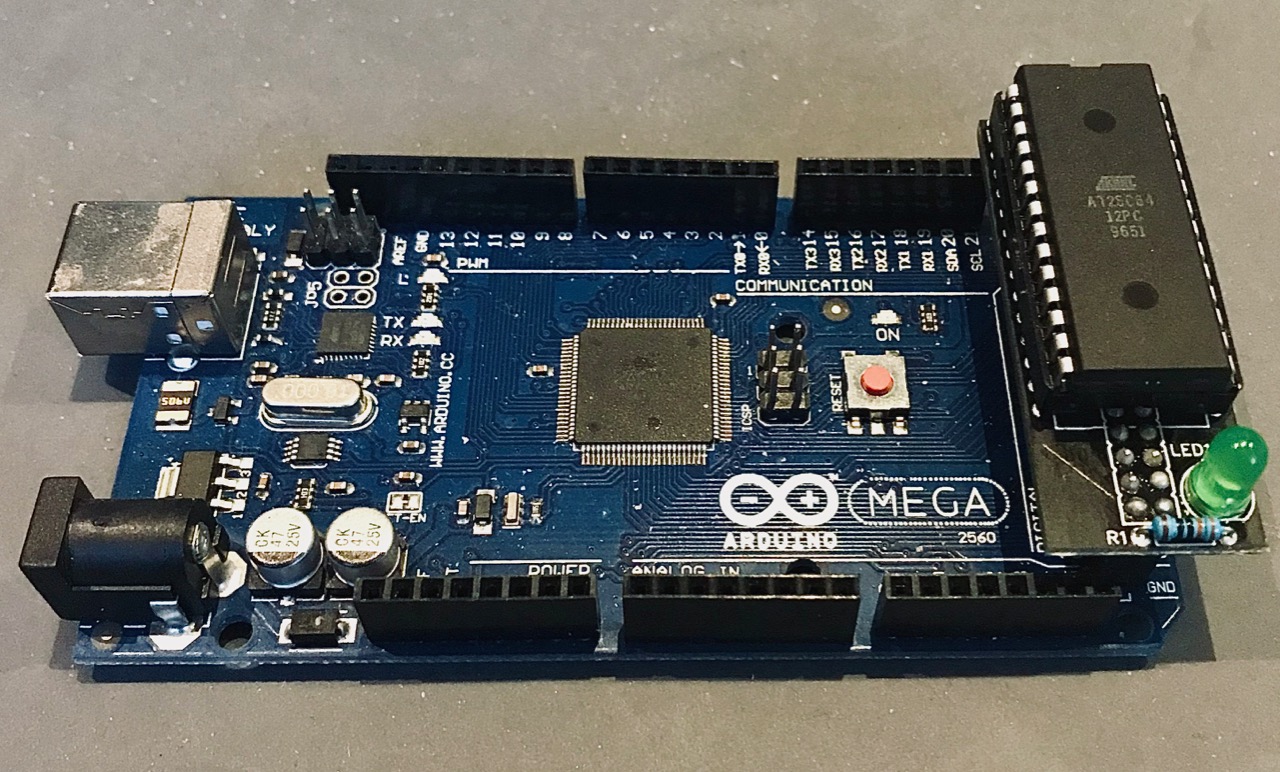This adapter can read and write AT28C64 and AT28C256 EEPROM chips using Arudino Mega. Creating converter PCB for this task recommended, but not mandatory. (see below for details)
This library is made for the arduino mega microcontroller, because thats the most common and cheapest solution. For other device there is no remapping options, yet. We will use the double row pin heads at the middle of the mega (pin 22-53)
Default arduino mega pin layout
/*
Arduino Mega 2560 Pin layout
22 RDY VCC
24 A12 23 WE
26 A7 25 NC
28 A6 27 A8
30 A5 29 A9
32 A4 31 A11
34 A3 33 OE
36 A2 35 A10
38 A1 37 CE
40 A0 39 IO7
42 IO0 41 IO6
44 IO1 43 IO5
46 IO2 45 IO4
GND 47 IO3
53 INDICATOR_PIN
*/You can order a working PCB using the generated gerber file or do it yourself at home using this one sided svg image.
Check the example files provided by this library. The adapter can read and write from/to your AT28 chip and the serial library can control the adapter via serial port commands.
This is a low level adapter, which can read and write data directly from/to the given address. You can run these operations one by one. No need for delay, the library will take care of it. If you need automatisation or more controlled handling, please check the EEPROMSerial class, which allows you to control your commands via serial port. (or any stream compatible way)
It doesn't have any input parameters and it won't initialise the adapter for you. You have to call the init function manualy when it's appropiate to set up the IC pins.
You must call this method, before you start using the adapter. (you also need to do it before you pass it to the EEPROMSerial instance) It will initialize your pins and sets the initial states of your IC.
This method reads the value of the memory block on the given address which is a decimal number. The maximum address depends on the chip itself. If you give a bigger number, then the script will chop of the higher bits. If you have the smaller memory chip, then it will set those pins also, but most of these overlapping pins are status pins or not connected on the smaller one. (for further details, please check the Atmel datasheets)
Example:
uint16_t address = 1001;
uint8_t value = adapter.read(address);
Serial.print("Address: ");
Serial.print(address);
Serial.print(" Value: ");
Serial.println(value);This methods will update your chip's memory block on the given address. These chips are all having 8 bit long data blocks, so your input data must be below 256. If you give a higher number, then the code will chop of the extra bits, so be cautious. The maximum writable address depends on the chip itself. If you give a bigger number, then the script will also chop of the higher bits.
Example:
uint16_t address = 1001;
uint8_t value = 200;
adapter.write(address, value);This is a helper object, which is using the EEPROMAdapter to read or write to your memory via serial port commands.
You can provide a Serial input, output stream and an adapter instance. If the in/out stream is the same, then you can use the simplified constructor to provide for both the same stream handler.
It starts to listen to the provided stream output and it parse and executes the commands which is received on the serial port. The following commands are available:
- Read: You can read a memory address with this command. Syntax: rAAAAA, where r is the read flag and AAAAA is the address. Example:
r00000will read the first memory address. - Write: You can write to the given memory address with this method. Syntax: wAAAAADDD, where w is the write flag and AAAAA is the address, DDD is the value. Example:
w00000255will write all ones to the first memory address.
The maximum address is depends on the EEPROM-s capacity, but the block size is always 8 bit, so the maximum value is 255 on a single block. All the input numbers are decimals and the adapter will convert them into binary values. Flags are case insensitive. (both r/R and w/W can be used to send commands to the listener)

